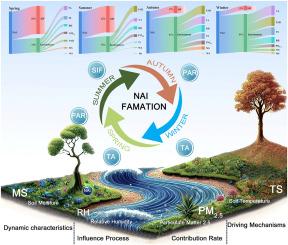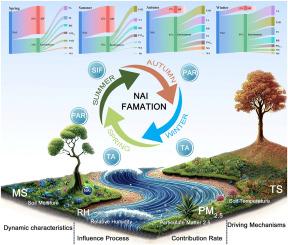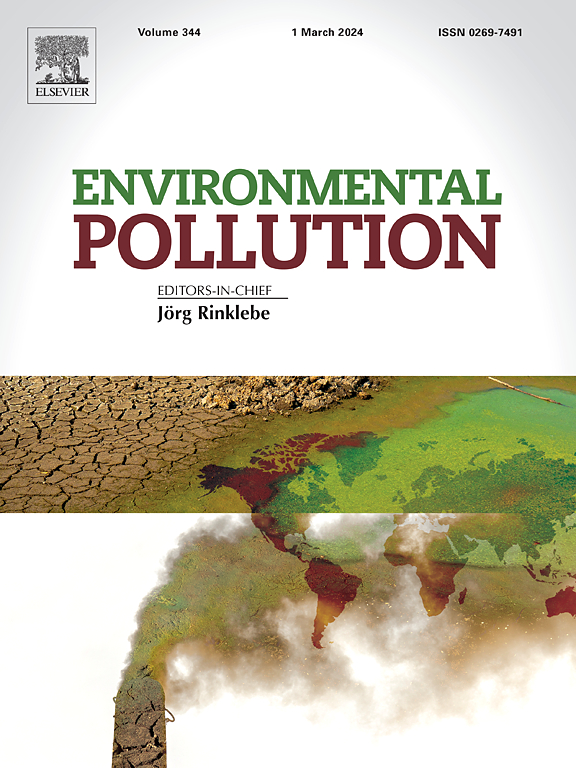Empirical analysis of the influence mechanism of vegetation and environment on negative air ion in warm temperate forest ecosystems
IF 7.6
2区 环境科学与生态学
Q1 ENVIRONMENTAL SCIENCES
引用次数: 0
Abstract
Air pollution presents a significant threat to public health in megacities globally. Negative air ions (NAI), often referred to as “air vitamins,” are recognized for their effectiveness in alleviating the harmful effects of air pollution. Forest ecosystems serve as natural generators of NAI, with both vegetation and environmental conditions playing critical roles in the formation and persistence of NAI. Gaining a comprehensive understanding of how forest ecosystems regulate NAI production is essential for leveraging their potential to enhance air quality. However, the intricate dynamics of forest ecosystems, along with seasonal fluctuations in vegetation and environmental factors, introduce uncertainties in NAI generation. This study utilized long-term observational data to explore the relationships between environmental variables, vegetation photosynthetic capacity (using solar-induced chlorophyll fluorescence, SIF), and NAI concentrations. By employing machine learning algorithms, we analyzed the spatiotemporal distribution of NAI, identifying the key contributing factors and their relative influence within forest ecosystems. The results revealed distinct seasonal variations in NAI levels, with higher values in summer and lower in winter. SIF and PM2.5 primarily influenced NAI through direct effects across seasons, whereas ambient temperature (TA), relative humidity, photosynthetically active radiation (PAR), and soil moisture predominantly impacted SIF on NAI through indirect effects in summer. TA was the primary influencing factor in spring and winter, contributing 28% and 25%, respectively, while PAR played a more significant role in summer and autumn, accounting for 37% and 27%. Vegetation had a greater impact on NAI levels during spring and summer, contributing 66% and 62%, whereas environmental factors dominated in autumn and winter, with contributions of 83% and 89%. This study offers both a theoretical foundation and technical guidance for enhancing the role of forest ecosystems in improving air quality and human living environments.


暖温带森林生态系统中植被和环境对空气负离子影响机制的实证分析
空气污染严重威胁着全球特大城市的公众健康。空气负离子(NAI)通常被称为 "空气维生素",在减轻空气污染的有害影响方面具有公认的功效。森林生态系统是空气负离子的天然生成器,植被和环境条件在空气负离子的形成和持久性方面发挥着至关重要的作用。全面了解森林生态系统如何调节净空气污染的产生,对于发挥森林生态系统改善空气质量的潜力至关重要。然而,森林生态系统错综复杂的动态变化,加上植被和环境因素的季节性波动,给净空气影响的产生带来了不确定性。本研究利用长期观测数据,探索环境变量、植被光合能力(使用太阳诱导叶绿素荧光,SIF)和净减排浓度之间的关系。通过采用机器学习算法,我们分析了净减排量的时空分布,确定了森林生态系统中的关键因素及其相对影响。结果显示,NAI 水平存在明显的季节性变化,夏季较高,冬季较低。SIF和PM2.5在不同季节主要通过直接效应影响净空气指数,而环境温度(TA)、相对湿度、光合有效辐射(PAR)和土壤湿度在夏季主要通过间接效应影响SIF对净空气指数的影响。TA是春季和冬季的主要影响因素,分别占28%和25%,而PAR在夏季和秋季的作用更大,分别占37%和27%。植被在春季和夏季对净空指数水平的影响更大,分别占 66% 和 62%,而环境因素在秋季和冬季占主导地位,分别占 83% 和 89%。这项研究为加强森林生态系统在改善空气质量和人类生活环境方面的作用提供了理论基础和技术指导。
本文章由计算机程序翻译,如有差异,请以英文原文为准。
求助全文
约1分钟内获得全文
求助全文
来源期刊

Environmental Pollution
环境科学-环境科学
CiteScore
16.00
自引率
6.70%
发文量
2082
审稿时长
2.9 months
期刊介绍:
Environmental Pollution is an international peer-reviewed journal that publishes high-quality research papers and review articles covering all aspects of environmental pollution and its impacts on ecosystems and human health.
Subject areas include, but are not limited to:
• Sources and occurrences of pollutants that are clearly defined and measured in environmental compartments, food and food-related items, and human bodies;
• Interlinks between contaminant exposure and biological, ecological, and human health effects, including those of climate change;
• Contaminants of emerging concerns (including but not limited to antibiotic resistant microorganisms or genes, microplastics/nanoplastics, electronic wastes, light, and noise) and/or their biological, ecological, or human health effects;
• Laboratory and field studies on the remediation/mitigation of environmental pollution via new techniques and with clear links to biological, ecological, or human health effects;
• Modeling of pollution processes, patterns, or trends that is of clear environmental and/or human health interest;
• New techniques that measure and examine environmental occurrences, transport, behavior, and effects of pollutants within the environment or the laboratory, provided that they can be clearly used to address problems within regional or global environmental compartments.
 求助内容:
求助内容: 应助结果提醒方式:
应助结果提醒方式:


